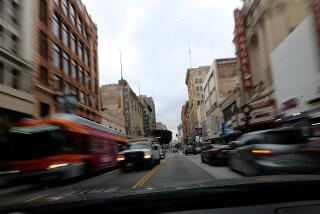Renovation of Wright house may stall out
After nearly three years and $17 million, Frank Lloyd Wright’s landmark, city-owned Hollyhock House and the adjacent Barnsdall Park may still remain closed to the public when the first of two renovation phases is finished late this spring, city officials said Wednesday. And there are currently no plans and no money for the second phase.
The 1921 home in Hollywood and surrounding buildings have been closed for earthquake repairs, utilities upgrades and a restoration of the steep, 90-foot hillside to its original landscaping plan. The park includes two newer structures that house art classrooms, a gallery for art exhibitions and a theater.
It will take years and millions of dollars -- a total of $19 million by the city’s current rough estimate -- to restore the still-dilapidated Hollyhock House and a nearby guest house to their early splendor, officials told exasperated citizens at a community meeting.
The roof of Hollyhock House, renowned for its evocation of ancient Mayan architecture, is no longer at risk of caving in during an earthquake, officials said. But it is uncertain whether the house Wright designed for oil heiress Aline Barnsdall on the site overlooking Hollywood Boulevard will meet building and safety codes necessary for occupancy -- even for limited tours.
The first restoration phase on Hollyhock House and the rest of the 38-acre Barnsdall Art Park is coming in 70% over its initial $10-million budget. Work should be finished by May 15, barring delays due to bad weather, said Bill Lukehart, the city Recreation and Parks Department’s superintendent for planning and construction. He said his department still hasn’t secured the final $6 million needed to pay the contractors but is looking to tap into the pool of money from Proposition G, a bond issue passed in 1990 to pay for earthquake damage to city-owned buildings. Lukehart, new to the parks department, said the original plan was “overly optimistic” and created “expectations that were not achievable.”
The second phase calls for further structural strengthening and the bulk of the refurbishing work. The city has owned the house and grounds since 1927, when Barnsdall, who lived there for just a few years, donated it as an art center.
More than 50 supporters of Hollyhock House, community leaders and citizens who value Barnsdall Park’s neighborhood art programs, turned up for the progress report at a meeting hall near Griffith Park. Some could not contain their dismay at phase one’s outcome: In addition to being late and over budget, the project will leave far less space for art classes. Because the guest house, which was used as an adult art center, is in such poor shape -- “the gas is leaking so badly, I’m surprised it didn’t explode,” said the project’s construction supervisor -- courses that had enrolled more than 300 adults and children will be crammed into a single building. And a popular ceramics program can’t be revived because kilns are located at the closed guest house and can’t easily be moved.
“Silly planning,” “fiasco,” “betrayal” and “just unacceptable” were among the salvos directed at the podium.
“Barnsdall Park without its heart, Hollyhock House, is a pretty sad place,” Shelah Lehrer-Graiwer, president of the Friends of Junior Arts Council, a private nonprofit group that sponsors arts classes, said of the prospect of reopening the park but keeping its most famous feature closed.
Pat Burke, of Swinerton Management & Consulting, the company hired to oversee the job, said the extent of the historic buildings’ woes was not clear until work began.
Crucial steps accomplished in the first phase include reinforcing the Hollyhock House and guesthouse roofs and anchoring them to the walls to prevent a collapse during a quake, Burke said. “They were set up by Frank Lloyd Wright as if they were magically going to stay together. We’ve tied them together to make sure in the next earthquake they don’t completely fall apart.”
Wright is famous for having accomplished artistic magic at the expense of practical considerations such as watertight roofing.
Now Hollyhock House “won’t leak anymore,” Burke said. “You’ll be able to enjoy it without wearing a raincoat.”
That’s if building officials rule it sufficiently safe and handicap-accessible to allow limited tours.
Based on what it’s like inside, it would be best to keep the building closed, said Scott Crawford, vice president of Friends of Hollyhock House. “The roof won’t be leaking, but the walls are peeling and it smells dank. The carpeting should have been thrown out 10 years ago. How do you want to represent Los Angeles? It’s a disaster.”
But showing off a tarnished jewel might help make the case for raising and spending the additional millions needed to restore it, said Brenda Levin, the architect who designed the seismic retrofit. Levin said that the first phase did accomplish a full restoration of the distinctive stone-and-concrete decorations, shaped like hollyhock flowers, that adorn the main house and the guest building. The upper reaches of the buildings also have been restored to their original olive-green color, she said.
Paul Gamberg, president of the Barnsdall Art Park Foundation, said the mission now will be to raise the money to fund the second phase. He warned officials that the community won’t be on board unless there’s more accountability. Three city agencies -- recreation and parks, cultural affairs and general services -- are involved in the restoration, programming and upkeep of the park.” The fate of this park depends on an administrative shakeup,” he said. “We demand a czar -- one individual who is responsible for this park.”
More to Read
Sign up for Essential California
The most important California stories and recommendations in your inbox every morning.
You may occasionally receive promotional content from the Los Angeles Times.










